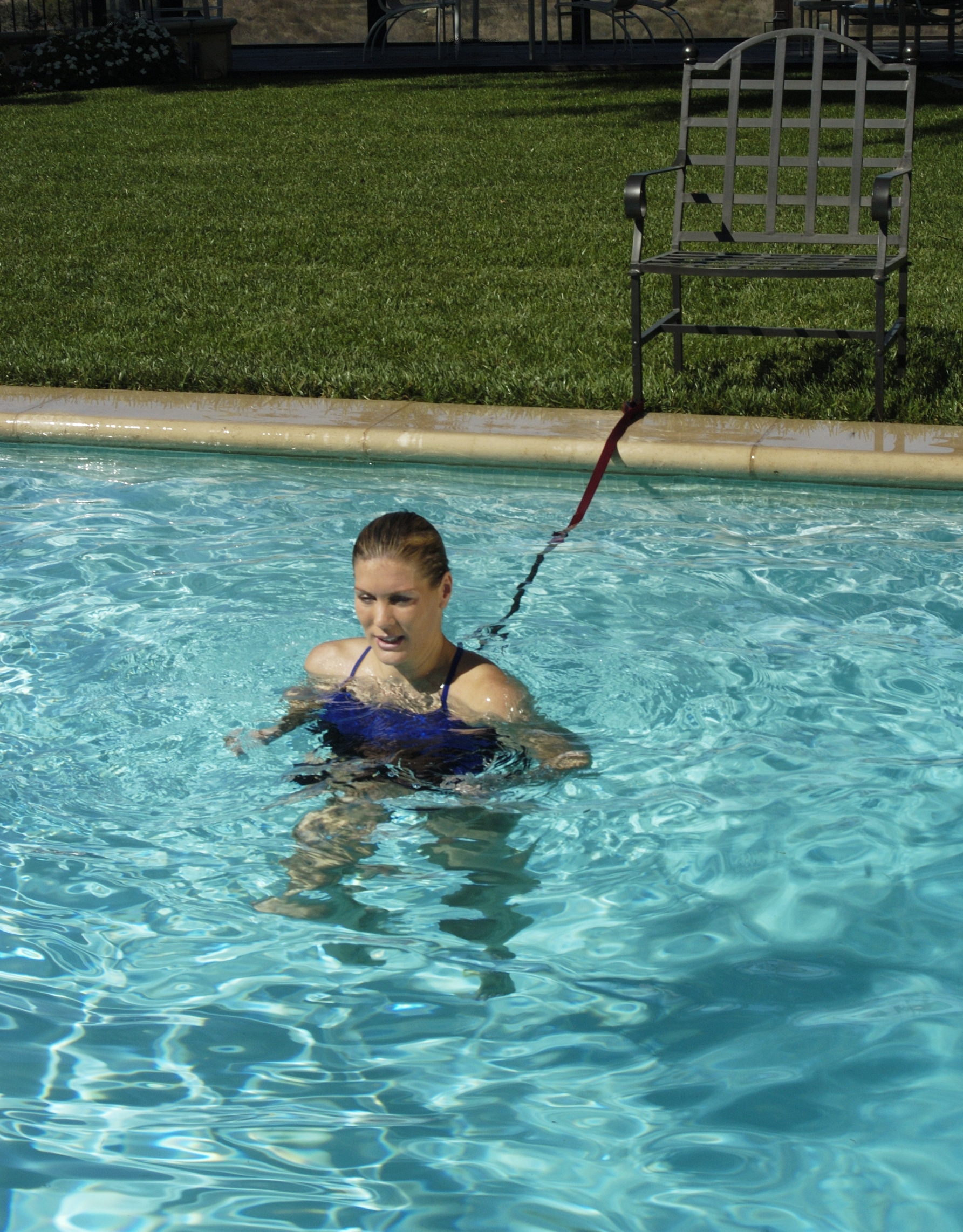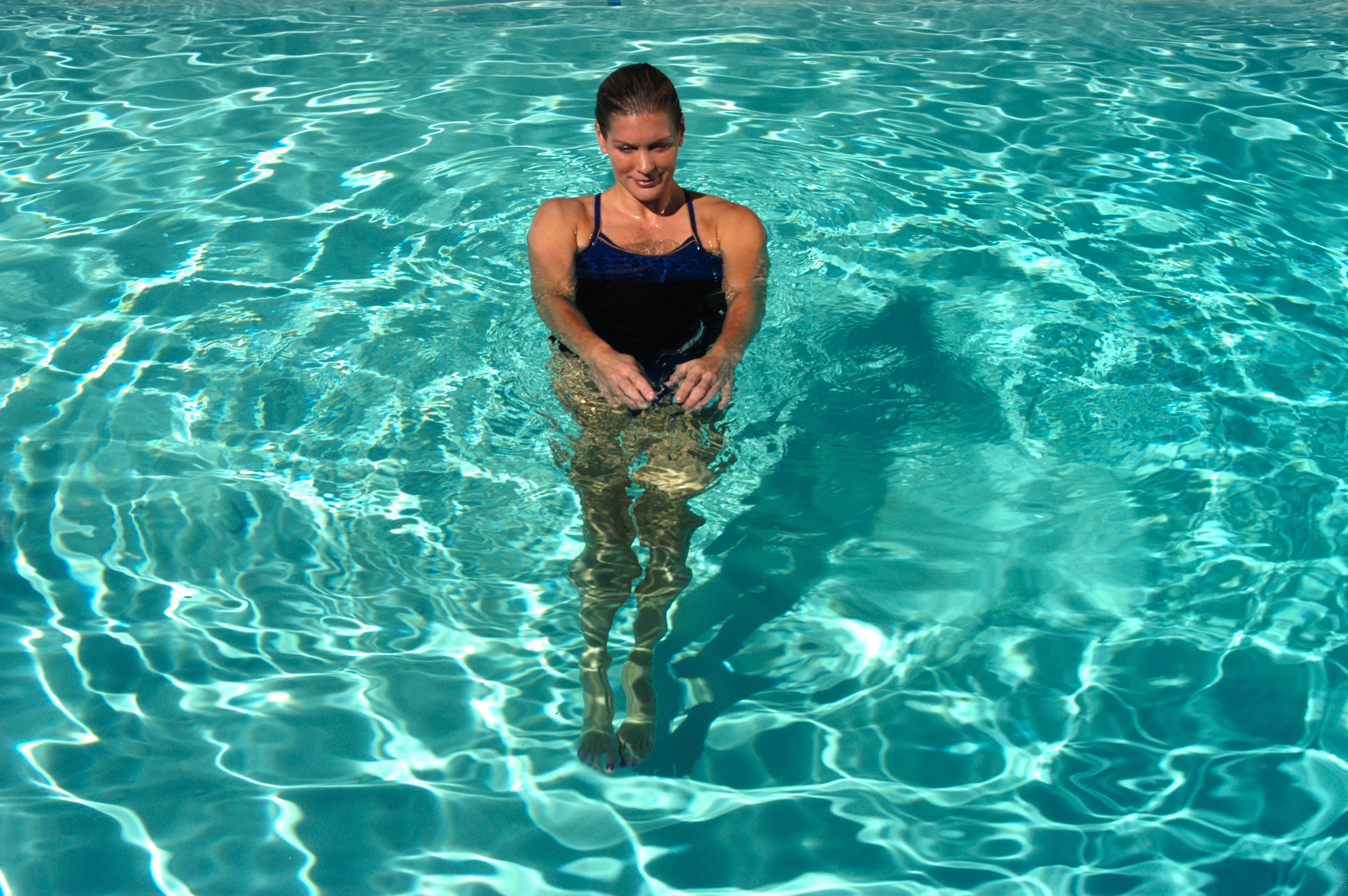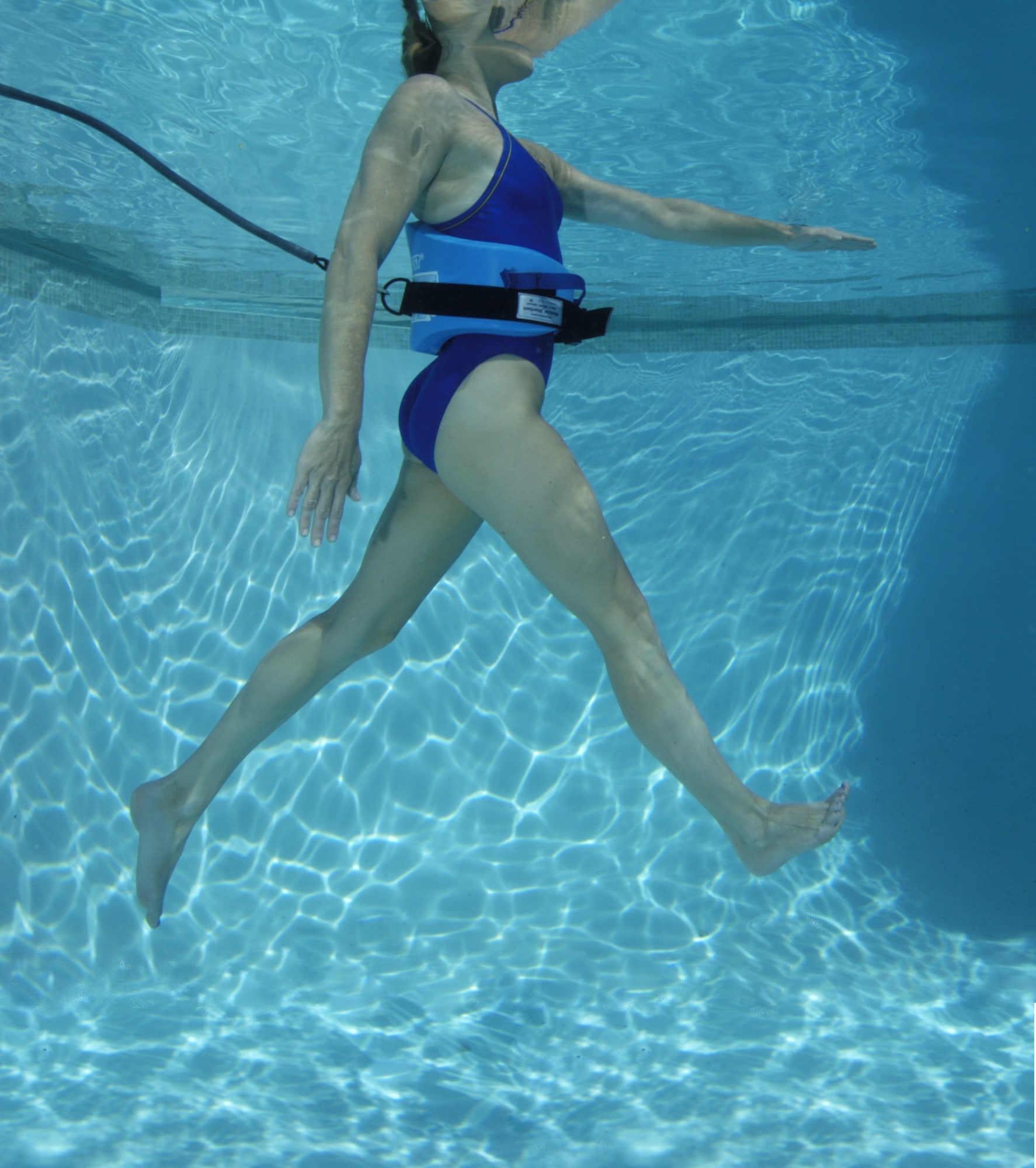You knew in your heart something was wrong. You knew that pain was not the kind of pain you could run through, but you pushed it aside and kept going. Soon you were in the doctors office, and they said the one word you hoped they would not say, rest.
You haggle with your physician, and they agree to let you cross-train if it does not irritate your injury. You frantically begin to search the internet for the best way to stay in shape. Short of spending thousands on an Alter-G treadmill or an Elliptigo, what is the next best thing?

Pool Running.
We have talked about the research behind pool running in the past, and shared 7 workouts that will make you feel like your heart is going to explode, but today we are taking it one step further. Giving you advice from an expert who explains (and demonstrates) exactly how to pool run correctly, so you not only maintain your fitness, but you may even come out in better fitness than had you been running all along.
If you want to keep your running fitness during injury, this post is for you.
This guest post was written by Lynda Huey
When I took the first few UCLA distance runners into the pool in 1983, virtually no one was cross training in water. They found it an odd idea. But when runners can’t run, they become desperate – desperate enough to put on a bathing suit and try it out.
We started doing the full running motion, which included a foreleg reach, but we quickly discarded that. The resistance of the water slowed the motion so proper speed could not be attained. These days, we use that old “full running motion” for recovery, especially when hamstrings are sore. But during all other training cycles, we do the back half of the running motion only. That’s the technique that allows runners to reach top speed.
Deep-Water Running
Now:
In deep water, we do only the back half of the running motion; that is, there’s no forward reach with the foreleg and foot. In fact, I tell runners that if they can see their feet they’re not running correctly. One knee lifts while the other foot drives down and back.
We use this running form so we can move quickly enough to duplicate the effort and speed of high-intensity running. Once you have mastered the Knee Up/Foot Down motion, start using the same good arm action as proper running form on land. Pull the elbows straight back. Pull the hand all the way back to an imaginary hip pocket. Keep the chest erect and the shoulders relaxed and down. Find a focal point at eye level ahead of them. That keeps the head level. Don’t let the shoulders wobble. Work to establish smooth, efficient running form without any extraneous movement.
Here are the most common mistakes:
- Swinging the arms across the chest. The arms should be pulled straight forward and back.
- Rocking the shoulders forward and back. The shoulders should remain stationary while the arms move at the shoulder. The whole torso should be solid and motionless. Only the arms and legs move.
- Bending and straightening the elbow. The elbow should remain bent at 90 degrees and the movement should take place only at the shoulder.
- Not pulling the elbows back far enough. Emphasize pulling the elbow back and your hand will come all the way to your hip.
- Rocking the head from side to side. Keep the head level without motion.
[bctt tweet=”Uh Oh! I just realized I was pool running incorrectly. This article from @Runners_Connect explains how to do it right” via=”no”]
Without a tether, the tendency will be to lean forward and try to reach the other side of the pool. The point isn’t to travel anywhere but to focus on turnover rate and good form. So keep the chest lifted or get a tether to help with good form. You can attach it to a ladder, a starting block, or even your athletic bag placed poolside. If you’re in an outdoor pool, you can attach the tether to the leg of a lounge chair or even to a rope tied to a tree.
Deep-Water Running on a Tether
If it’s a casual workout, I might let the runners move around the pool. The same is true for a recovery workout after competition or a tough workout.
But if the intent of the workout is focused, high-intensity training, I put all the runners on a tether so there are no distractions. Without having to think about turning or avoiding others in the pool, the runners can put their attention on the mental part of the workout.
Workouts Specific to the Distance the Athlete is Training For
I put runners together who run similar distances so they can calculate the correct cadence for the workout. If I ask elite distance runners for a 5-minute mile pace, they will find the right cadence that will translate to that pace together.
I will put the 5K and 10K runners together. They will run intervals per their coaches’ instructions and we will monitor the work based on time rather than distance.
For instance, if the coach wants the 5K runners to do 4 x 800M, I ask them each to hit the pace they could hold for 2 minutes and I will talk them through two laps of the track. Even though most world-class tracks have longer turns and shorter straight-aways than they did twenty years ago, I still use my same formula: every 15 seconds equals 100M, and I consider each 100M either a turn or a straight-away.
Milers
When the milers start their first 800, I’ll get them started at an easy running speed and make any corrections on form. Then I’ll say, “Ready, GO! Out around the first turn. Establish your speed.” I will keep up the chatter to help them internally visualize that they are running on a track. “Top of the turn,” I will say about 7 seconds into it, then at the 15-second mark, I’ll say, “Coming out of the turn. You’re on the first backstretch now. Maintain your good form and keep the pace you’re supposed to run.”
I will talk them through the second turn and the home stretch then do the same thing for the bell lap. When they hit the home stretch for the second and final time, I start clapping my hands and tell them to “Lift, go into your kick, use your arms.”
All the things their coaches would say to them during a race. I watch the clock, but I want them keeping their eyes forward, their heads steady. So I count down the last 50M for them. “40M, 30M, 20M, 10M….STOP!” Their effort ceases and they start their easy-movement recovery before getting ready for the next 800.
10k Runners
The 10K runners might do 4-lapper, 6-lapper, or 8-lapper repeats, so we’ll pace those out as if on a track, too. And again, I’ll talk them through each lap, which equates to 60 seconds on the clock.
The narrative I use to keep them motivated might put their biggest rival right beside them. I might say that the rival has pulled ahead to make the athlete I’m training work harder, both physically and mentally. Over the 8-lapper, that lead can go back and forth a few times to keep the interest level high.
At the end, I like to let my athlete edge out the rival. That builds more mental confidence.
[bctt tweet=”Learning about how to use deep water running correctly to maintain fitness during injury”]
Marathon Runners
On the other end of the spectrum, when I work with marathoners, we might simulate a 10-mile run that they can mentally picture over familiar terrain.
It helps if I know the course, but if not, I let them do the running at a specified pace and I ask them to keep me posted if we’re approaching an uphill or downhill.
If they tell me there’s a hill at the 9-minute mark, I start telling them about it at 8:30, asking them to summon up their strength, then push them verbally up the hill, asking for increased effort and force against the water.
Although they enjoy having training partners, they do equally well without a partner as long as I keep the commentary going so they can mentally be running on their favorite ten-mile loop.
We spend a lot more time in the pool running, because marathoners have to train many more miles (which are measured in minutes) than runners who race shorter distances.
The mental aspect of pool training can’t be underestimated. Anyone can do the running, but it requires the mental work to create training that carries over and shows up in the athletes’ first land workouts when they come back to land. The mental work gives the athlete confidence.
Other Exercises Using Deep-Water
Besides running, I use other deep-water techniques to provide variety, strengthen muscles in different ways, and break up all the forward and backward motion. Flies are a great exercise for strengthening the inner and outer thighs during the recovery time between intervals.
Flies
Have your runners lean slightly backward until they learn the balance point on this exercise. Then they can assume the upright position shown in the photos below.
Start with the arms together and the feet together (photo A). Then open the arms and legs wide to the position in B. The hands are in a palms-down position just beneath the surface of the water so that they “slice” through the water with little resistance.
Close the arms and legs again and continue with Flies. Use Flies for 30 seconds to two minutes of recovery. Virtually all elite athletes recover in two minutes, regardless of how hard they were working.
Power Walk
Hold one arm and the opposite leg forward. Now switch positions so the other arm and leg are forward. Keep both arms and legs straight throughout this motion. Turn the hands wide like paddles so that the palms face backward through the forward and backward motion of the arms. Then lift the toes up on the leg that is moving forward and at the same time point the toes down on the leg that is moving backward.
I use the commands: “Flex-Up, Point-Back.” When asking the runners to work harder on this exercise, I use the commands: “Push Forward, and Back, and Forward, and Back.”
The muscles that are fairly neglected in deep-water running are the calf muscles. We add the pointing and flexing of the feet to create work for the calf muscles in Power Walk in order to correct that imbalance.
Distance runners often experience over-use injuries because of the repeated micro-trauma that comes from “pounding the pavement.” Micro-trauma is the repetitive stress placed on tissues over time that result in a cumulative injury. The minor pain at the onset of common over-use injuries is an example of micro-trauma that left unattended eventually leads to dysfunctional injuries. Below is a list of the most common injuries that plague distance runners – they all can be caused by over-use.
- Runner’s knee – pain around or behind the kneecap
- Achilles tendinitis – inflammation of the Achilles tendon
- Plantar fasciitis – a painful, inflamed thick band of tissue that runs along the bottom of the foot connecting the heel bone to the toes
- Shin splints –pain along the shin bone (tibia), the large bone at the front of the lower leg; often a first-year runner’s ailment
- Iliotibial band syndrome – a tight or inflamed ligament that runs down the outside of the thigh from the hip to the knee, often causing knee pain
- Stress fracture – a crack in a bone caused by repetitive stress rather than sudden trauma
- Patellar tendinitis – inflammation of the patellar tendon, the connective tissue that attaches from the bottom of the kneecap onto the tibia
The best way to avoid these injuries is to turn to the pool at the first sign of over-use pain. By doing a high-intensity workout in the pool, you can “take a day off without taking a day off.” Start cross training right away and don’t go back to running on land until you can run in chest-deep water without pain.
If you want to learn more about pool running, be sure to take a listen to our podcast with Lynda; 7+ Ways Cross Training Will Make You A Better, Stronger, Runner- Alan Webb, Darren Brown & Lynda Huey. This will really open your eyes, it’s worth a listen….especially if you are injured!
 Lynda Huey, M.S. founder of Huey’s Athletic Network and CompletePT, pioneered the use of water rehabilitation with Olympic and professional athletes in the 1980s. She trains aquatic therapists from Australia, Europe, South America and the Middle East as well as from private clinics, hospitals, and universities. Her five books on water exercise and rehabilitation are considered the foundation of aquatic therapy world-wide. Learn about her aquatic rehab online course at LyndaHuey.com
Lynda Huey, M.S. founder of Huey’s Athletic Network and CompletePT, pioneered the use of water rehabilitation with Olympic and professional athletes in the 1980s. She trains aquatic therapists from Australia, Europe, South America and the Middle East as well as from private clinics, hospitals, and universities. Her five books on water exercise and rehabilitation are considered the foundation of aquatic therapy world-wide. Learn about her aquatic rehab online course at LyndaHuey.com










One Response
Do you think I can do this with high hamstring tendinopathy without delaying healing? I can’t run or ride and I need something besides swimming laps